| Oct-01-16 | | Gregor Samsa Mendel: Black's pieces are in no position to help their denuded king. If fact, they worsen the situation by blocking all possible avenues of escape. |
|
| Oct-01-16 | | Gregor Samsa Mendel: In fact, The Emperor Has No Clothes. |
|
Oct-01-16
 | | An Englishman: Good Evening: 2.d3 vs. the French look like such a modest, even timid, move--and yet it packs quite a lot of firepower. ...0-0, such a natural move, seems so risky in this variation even when the move is sound. |
|
| Oct-01-16 | | YouRang: Saturday 16.?
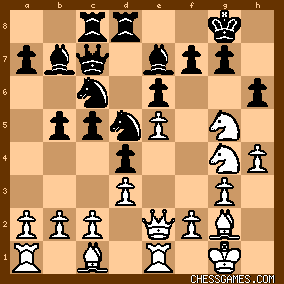
click for larger view
I (white) have a nice stack of knights and my Bc1 ready to assault the black K, but Ph6 is attacking my Ng5. What looks attractive to me here is <16.Nxh6+> expecting <16...gxh6>. - It's forcing (check)
- It busts the king defense open.
- It vacates g4 for my queen.
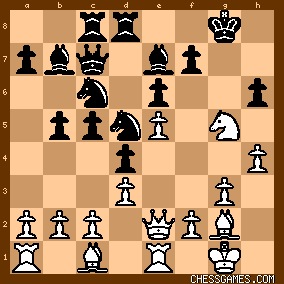
click for larger view
So my Ng5 is under attack again. Do I dare spend it on *really* demolishing black's defense with <17.Nxf7>? Yes! Because 17...Kxf7 is met by 28.Qh5+ Kg7 29.Qxh6+ and the Q and bishop will have a field day with black's exposed K. But if black can't take my poisoned Nf7, it has to do something about the threats being posed (e.g. Nxd8, Nxh6+, Qg4+, etc). Black's best bet may be add a defender with <27...Bd8> (guarding Ph6 and opening the 7th rank for the Q to help out).
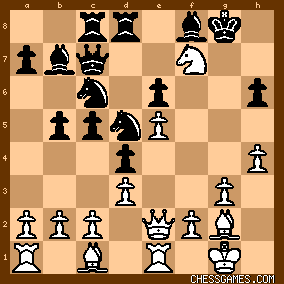
click for larger view
Here I have a choice of 18.Nxd8 (take the exchange) or 18.Nxh6+ (win a pawn with continuing attack on naked black K). If I opt for the latter, then <18.Nxh6+ Bxh6 19.Bxh6>
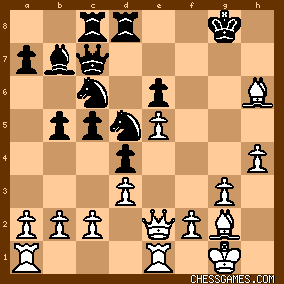
click for larger view
Materially it's about even, if you equate a N to 3 pawns. But given that those 3 pawns were the black king's defensive line, I'm thinking white has the better of the deal. I have Qg4+, Bh3, and maybe even a rook lift (Re4) at my disposal, so I'm happy with this. ~~~~
I was mildly surprised that my line wasn't the "puzzle solution" line, but it's still considered "pretty good", which is usually good enough for me on Saturday. Indeed the better plan was 16.Nxf7! first followed by Nxh6+, but even if I considered it, I'm not sure I would have figured out why it's better. |
|
| Oct-01-16 | | Aunt Jemima: I missed this one. I tried Nxe6. |
|
Oct-01-16
 | | al wazir: <Aunt Jemima: I tried Nxe6.> Me too. It's obvious to anyone familiar with <CG> puzzles that if white wins in this position it has to be by sacrificing pieces to demolish the ♙ screen in front of black's ♔. So the question is, which minor pieces martyr themselves and in what order? I suspect that it doesn't matter. I think that 16. Nxe6 and 16. Nxh6 also win. For example, after 16. Nxh6 gxh6 17. Nxe6 fxe6 18. Bxh6, the black ♔ is stark naked. |
|
| Oct-01-16 | | diagonalley: excellent example of sacrificial chess! |
|
| Oct-01-16 | | AlicesKnight: I was with <al wazir> and others - I missed the way that all the Black heavy pieces form a barrier which the exposed K cannot pass to safety - a remarkable self-block. |
|
| Oct-01-16 | | dnp: a bit off topic. Yesterday evening I was watching the Kramnik - Anand match live in the Tal memorial.
Vlada played 47. K-g2, why not R-c7? I mean he took a fair bit of time to make the move. |
|
| Oct-01-16 | | gofer: The start of this one gives us 3 pawns for our knight, but it is not
that that makes this combination work, it is the advanced state of
our kingside pawns. When/if we play Bxd5 Pd5 will have the strong
possibility of becoming a passed-pawn supported by three other
connected passed-pawns, which really isn't too shabby! <16 Nxh6 ...>
16 ... Kf8/Kh8
17 Nhxf7 
<16 ... gxh6>
<17 Nxf7! ...>
I prefer this over Nxe6 because it wins three pawns without risking another
piece. Nxe6 looks to be a knight sacrifice too far... 17 ... Bf8
18 Nxh6+ 
<17 ... Kxf7>
<18 Qh5+ Kg8>
<19 Qg6+ Kh8>
<20 Qxh6+ Kg8>
<21 Qxe6+ ...>
21 ... Kf8
22 Bh6+ Ke8
23 Qg8+ Bf8 (Kd7 24 Bh3#)
24 Qxf8 Kd7
25 Bh3#/e6#
<21 ... Kh8>
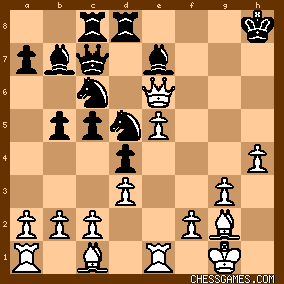
click for larger viewHmmm. I can see this leading nowhere fast. One line (other than the
perpetual check) might be...
22 Qh6+ Kg8
23 Qg6+ Kh8
24 Qh5+ Kg8
25 Bh6 ...
This might be okay?! Or perhaps the rook lift - if we have time for
it?! But one line that should be avoided is...
22 Bxd5 Rxd5
23 Qxd5 Nd8!
24 Qb3 Qc6!
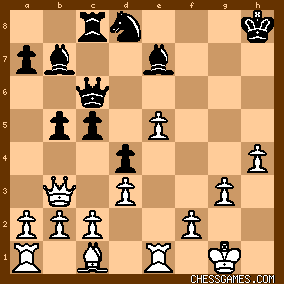
click for larger view25 Rd5 c4! wins the rook at the very least
Hmmm, going to have to check...
~~~
Okay, so I went wrong on move one... ...Doh! |
|
| Oct-01-16 | | mig55: If 21. .../Kd5.... 22. Qf7! |
|
| Oct-01-16 | | agb2002: Full material on the board.
Black threatens hxg5.
White can start the assault with 16.Nxh6+ (clearing the queen's path to h5 with tempo; Ne4, Nxe6, Nxf7, Nf6+, Nh7, etc. don't look so promising) 16... gxh6 (else 17.Nhxf7 wins a second pawn with an overwhelming position) 17.Nxf7: A) 17... Kxf7 18.Qh5+
A.1) 18... Kf8 19.Bxh6+ Kg8 20.Qg6+ Kh8 21.Qg7#. A.2) 18... Kg7 19.Bxh6+
A.2.a) 19... Kg8 transposes to A.1.
A.2.b) 19... Kh7 20.Be4+ Kh8 21.Bg5+ Kg7(8) 22.Qg6+ Kf8 (22... Kh8 23.Qh7#) 23.Bh6#. A.2.c) 19... Kh8 20.Re4
A.2.c.i) 20... Nxe5 21.Bf4+ (this would have been impossible if White had played 20.Bd2+ Kg8 21.Re4) 21... Kg8 (21... Kg7 22.Bxe5+ wins) 22.Bxe5 looks winning. For example, 22... Bd6 23.Rg4+ Kf8 24.Qh8+ Kf(e)7 25.Rg7#. A.2.c.ii) 20... Nf6 21.exf6
A.2.c.ii.1) 21... Bxf6 22.Bg5+ Kg7 (22... Qh7 23.Bxf6+ Kg8 24.Rg4+ wins) 23.Qh6+ wins decisive material. A.2.c.ii.2) 21... Bd6 22.Bg7+ Kg8 23.Rg4 Ne5 (due to the threats 24.f7+ Qxf7 25.Qh8# and 24.Bh6+ followed by 25.Rg7) 24.f7+ Nxf7 25.Bf6+ Kf8 26.Bxb7 Qxb7 27.Qh7 Ke8 28.Rg8+ Bf8 29.Qg7 seems to win decisive material. A.2.c.ii.3) 21... Ne5 22.fxe7 followed by Rxe5 wins. A.2.c.iii) 20... Bd6 21.exd6 Rxd6 22.Rg4 Qh7 23.Be4 looks crushing (23... Nf6 24.Bg7+ Kg8 25.Bxf6+ etc.). A.2.c.iv) 20... Bf6 21.Rg4 (21.exf6 Nxf6 seems to be more complex at least) looks winning (21... Qh7 22.Be4 as above). A.3) 18... Kg8 19.Qg6+ Kh8 (19... Kf8 20.Bxh6#) 20.Qxh6+ Kg8 21.Qxe6+ Kh8 22.Bxd5 Rxd5 23.Qxd5 looks good for White. For example, 23... Nxe5 24.Qxe5 Qc6 25.Re4 + - [R+3P vs B]. B) 17... Rf8 18.Nxh6+ and White has three pawns for the knight and attack. For example, 18... Kh8 19.Qh5 Bd8 20.Be4 Re8 21.Nf7+ Kg8 22.Qh7+ Kf8 23.Bh6+ Ke7 24.Nd6#. |
|
| Oct-01-16 | | MaczynskiPratten: Tough puzzle because of the multiple possible Knight sacs! I chose 16 Nxf7+ followed by 17 Nxh6+ but hadn't seen all the implications after Black declined the second sac with Ke8. Fortunately, as pointed out above, the Black K's escape to d7 is illusory as he can't get any further. |
|
Oct-01-16
 | | offramp: 16. Nh3 was better. |
|
| Oct-01-16 | | Rama: Not a 2-Bishop sac but a 2-Knight sac! Once I saw they could annihilate themselves the puzzle worked itself out. |
|
| Oct-01-16 | | RandomVisitor: After 16.Nxf7
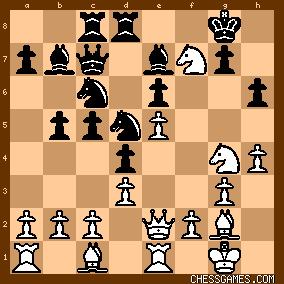
click for larger viewKomodo-10.1-64bit:
+2.56/29 16...Bf8 17.Nxd8 Nxd8 18.a4 b4 19.Bd2 Rb8 20.Be4 Bc6 21.Rec1 Ne7 22.Bxc6 Qxc6 23.b3 Nf5 24.Nh2 Qe8 25.h5 Nf7 26.Nf3 Be7 27.Qe4 a6 28.Rf1 Qd7 29.g4 Nh4 30.Nxh4 Bxh4 31.f4 Bg3 <+2.98/29 16...Kxf7 17.Nxh6+ Ke8 18.Qh5+ Kd7 19.Bxd5> Qa5 20.Bxe6+ Kc7 21.Bg5 gxh6 22.Bxe7 Nxe7 23.Qf7 Rd7 24.Bxd7 Kxd7 25.e6+ Kd6 26.c3 dxc3 27.bxc3 Qd8 28.a4 a6 29.d4 cxd4 30.axb5 axb5 31.Qf4+ Kc6 32.cxd4 b4 33.Rac1+ Kb6 34.Rxc8 Nxc8 35.Qxh6 Bc6 36.Qg5 Qxd4 37.h5 Nd6 38.h6 Ne4 39.Qf4 b3 40.h7 b2 41.Qf8 +5.96/29 16...Bg5 17.Nxd8 Bxd8 18.Nxh6+ gxh6 19.Qg4+ Kh8 20.Qxe6 Ncb4 21.Be4 Qg7 22.Qe8+ Qg8 23.Qh5 Rc7 24.Qxh6+ Rh7 25.Bxh7 Qxh7 26.Qd6 Bc7 27.Qxc5 Bb6 28.Qf8+ Qg8 29.Qh6+ Qh7 30.Re2 Qxh6 31.Bxh6 Nc7 32.f4 Kh7 33.Bg5 Nbd5 34.f5 Ne3 35.Bxe3 dxe3 36.Rf1 Kg7 37.c3 Bd5 38.d4 Bc4 39.Rxe3 Bxf1 40.Kxf1 Nd5 41.Re1 +6.39/29 16...Ne3 17.Nxd8 Rxd8 18.fxe3 h5 19.Nh2 Qxe5 20.exd4 Qxe2 21.Rxe2 Nxd4 22.Rf2 Bxg2 23.Kxg2 Bf6 24.Nf3 Nxf3 25.Rxf3 Rd6 26.Be3 Rc6 27.Re1 Bxb2 28.Rb1 Bf6 29.Rxb5 Ra6 30.Rb8+ Kf7 31.Bxc5 Rxa2 32.Rf2 a5 33.Rf8+ Kg6 34.Re8 e5 35.Bd6 a4 36.Bxe5 a3 |
|
| Oct-01-16 | | patzer2: I notice a recurring theme in this week's puzzle selection. Wednesday's solution 22. Bxh7+! in Koltanowski vs M Defosse, 1936 sacrifices two Bishops to demoplish pawn cover and expose an
under-protected, castled King to attack.
Today's Saturday solution 16. Nxf7+!! involves the same tactical theme (i.e. demolition of pawn structure), but with one obvious difference. Instead of two Bishops, it's two Knights sacrificing themselves to destroy pawn cover and attack a weak, king-side castled position. However, in attacking a weak, under-protected King-side, it's often not enough just to have the right general idea. Move order almost always matters. In this particular case, the question of which Knight to sacrifice first is important. The correct sequence is 16. Nxf7+!! Kxh7 17. Nxh6+!  (+2.96 @ 26 depth, Stockfish 7). Less accurate is 16. Nxh6+ gxh6 17. Nxf7 Bf8 (not 17...Kxf7?? 18. Qh5+ (+2.96 @ 26 depth, Stockfish 7). Less accurate is 16. Nxh6+ gxh6 17. Nxf7 Bf8 (not 17...Kxf7?? 18. Qh5+  ) 18. Nxh6+ ) 18. Nxh6+  ) 18. Nxh6+ Bxh6 19. Qf7 ) 18. Nxh6+ Bxh6 19. Qf7  (+0.91 @ 22 depth, Deep Fritz 15). (+0.91 @ 22 depth, Deep Fritz 15). One general rule in these demolition combinations, as pointed out by <YouRang> in Koltanowski vs M Defosse, 1936, is that after sacrificing minor pieces to destroy pawn cover, it's important to bring the Queen into play with check. In this Saturday puzzle solution, after either 17...Ke8 or 17...gxh6, the only clear winning move is 18. Qh5+  . . Black's decisive mistake was the not-so-obvious 15...h6?, allowing 16. Nxf7!!  . Instead, 15...Rd7 gives black reasonable counter chances as play might go 15... Rd7 16. Be4 Bxg5 17. Bxg5 Nce7 18. Nf6+ gxf6 19. exf6 Ng6 20. h5 Qe5 21. f4 Qd6 22. hxg6 fxg6 23. a4 b4 24. Bxd5 Bxd5 25. b3 . Instead, 15...Rd7 gives black reasonable counter chances as play might go 15... Rd7 16. Be4 Bxg5 17. Bxg5 Nce7 18. Nf6+ gxf6 19. exf6 Ng6 20. h5 Qe5 21. f4 Qd6 22. hxg6 fxg6 23. a4 b4 24. Bxd5 Bxd5 25. b3  (0.42 @ 22 depth, Deep Fritz 15). (0.42 @ 22 depth, Deep Fritz 15). One move earlier, Black might have improved with 14...Bf8 15. Ng5 h6 = to  (-0.33 @ 21 depth, Deep Fritz 15). (-0.33 @ 21 depth, Deep Fritz 15). |
|
| Oct-01-16 | | Milesdei: Everything about the position is screaming "SACRIFICE"! I saw the knight sacs in the right order but lost the thread after 18...Kd7. A gorgeous attack! |
|
|
|
|





